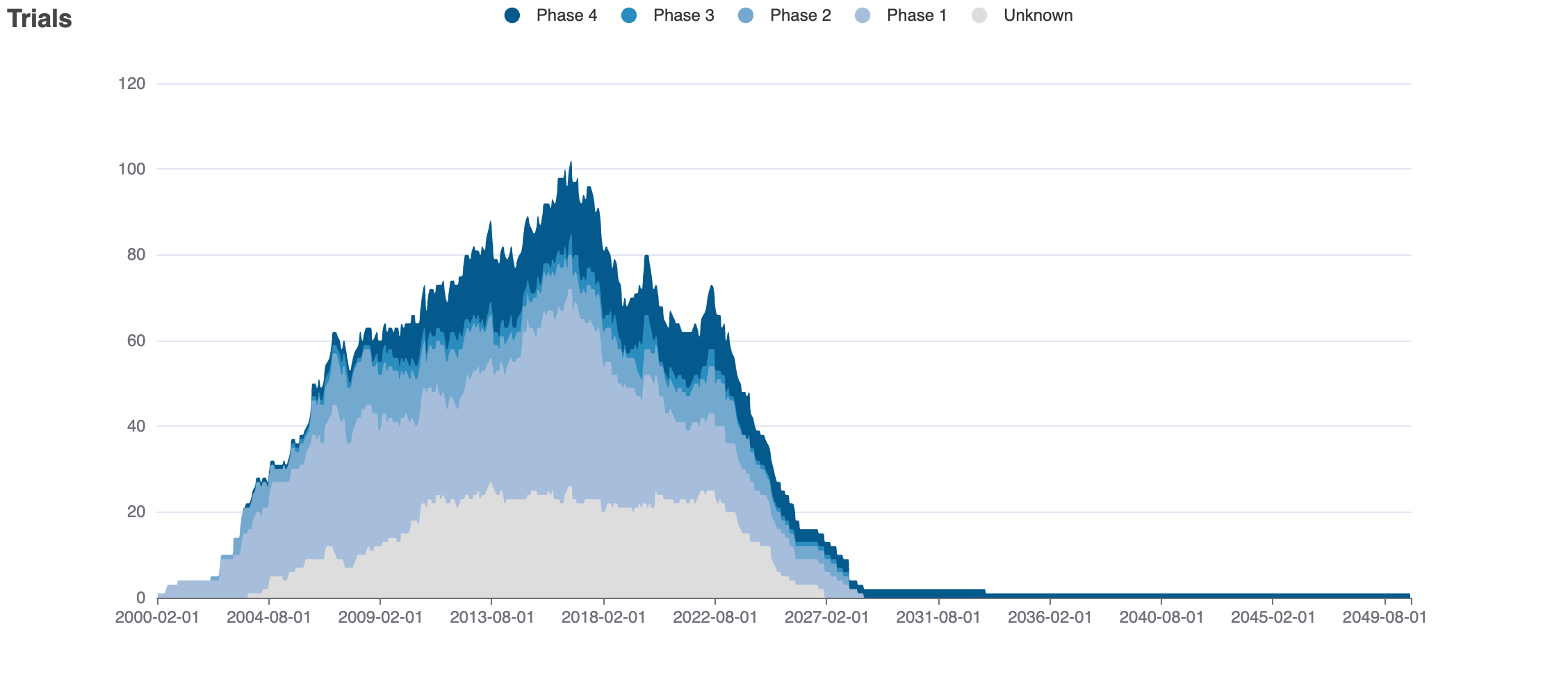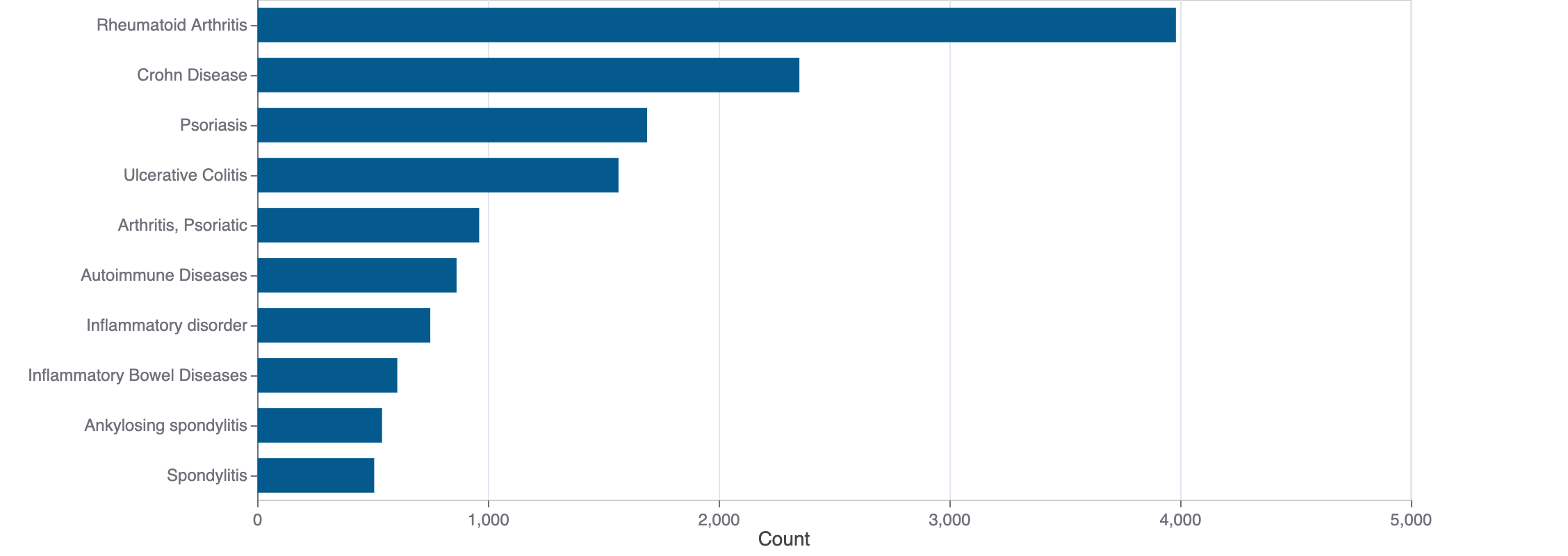Saracatinib
Saracatinib is a small molecule pharmaceutical. It is currently being investigated in clinical studies. The pharmaceutical is active against tyrosine-protein kinase Yes, tyrosine-protein kinase Lck, proto-oncogene tyrosine-protein kinase Src, and tyrosine-protein kinase ABL1.
Download report
Favorite
Events Timeline
Commercial
Clinical
Drug
Target
Variants
Financial
Trends
Safety
Events Timeline
5D
1M
3M
6M
YTD
1Y
2Y
5Y
Max
Events
FDA approval date
EMA approval date
Patent expiration date
Study first post date
Last update post date
Start date
Primary completion date
Completion date
Results first post date

Mock data
Subscribe for the real data
Subscribe for the real data
Commercial
No data
Clinical
Clinical Trials
35 clinical trials
View more details

Mock data
Subscribe for the real data
Subscribe for the real data
Indications Phases 4
No data
Indications Phases 3
Indication | MeSH | Ontology | ICD-10 | Ph 1 | Ph 2 | Ph 3 | Ph 4 | Other | Total |
|---|---|---|---|---|---|---|---|---|---|
| Ovarian neoplasms | D010051 | EFO_0003893 | C56 | — | 2 | 1 | — | — | 2 |
| Fallopian tube neoplasms | D005185 | — | — | — | 1 | 1 | — | — | 1 |
Indications Phases 2
Indication | MeSH | Ontology | ICD-10 | Ph 1 | Ph 2 | Ph 3 | Ph 4 | Other | Total |
|---|---|---|---|---|---|---|---|---|---|
| Neoplasms | D009369 | — | C80 | 4 | 2 | — | — | — | 6 |
| Prostatic neoplasms | D011471 | — | C61 | — | 1 | — | — | — | 1 |
| Breast neoplasms | D001943 | EFO_0003869 | C50 | — | 1 | — | — | — | 1 |
| Bone neoplasms | D001859 | EFO_0003820 | D16 | — | 1 | — | — | — | 1 |
| Bone diseases | D001847 | — | M89.9 | — | 1 | — | — | — | 1 |
| Myositis ossificans | D009221 | — | M61.1 | — | 1 | — | — | — | 1 |
| Fibrosis | D005355 | — | — | 1 | 1 | — | — | — | 1 |
| Idiopathic pulmonary fibrosis | D054990 | — | J84.112 | 1 | 1 | — | — | — | 1 |
| Pulmonary fibrosis | D011658 | — | J84.10 | 1 | 1 | — | — | — | 1 |
| Osteosarcoma | D012516 | — | — | — | 1 | — | — | — | 1 |
Show 1 more
Indications Phases 1
Indication | MeSH | Ontology | ICD-10 | Ph 1 | Ph 2 | Ph 3 | Ph 4 | Other | Total |
|---|---|---|---|---|---|---|---|---|---|
| Healthy volunteers/patients | — | — | — | 2 | — | — | — | — | 2 |
| Non-small-cell lung carcinoma | D002289 | — | — | 1 | — | — | — | — | 1 |
| Ovarian epithelial carcinoma | D000077216 | — | — | 1 | — | — | — | — | 1 |
| Parkinson disease | D010300 | EFO_0002508 | G20 | 1 | — | — | — | — | 1 |
| Psychotic disorders | D011618 | — | F20.81 | 1 | — | — | — | — | 1 |
| Mental disorders | D001523 | EFO_0000677 | F91.9 | 1 | — | — | — | — | 1 |
Indications Without Phase
No data
Epidemiology
Epidemiological information for investigational and approved indications
View more details
Drug
General
| Drug common name | Saracatinib |
| INN | saracatinib |
| Description | Saracatinib is a member of the class of quinazolines that is quinazoline substituted by (5-chloro-2H-1,3-benzodioxol-4-yl)amino, (oxan-4-yl)oxy and 2-(4-methylpiperazin-1-yl)ethoxy groups at positions 4, 5 and 7, respectively. It is a dual inhibitor of the tyrosine kinases c-Src and Abl (IC50 = 2.7 and 30 nM, respectively). Saracatinib was originally developed by AstraZeneca for the treatment of cancer but in 2019 it was granted orphan drug designation by the US Food and Drug Administration for the treatment of idiopathic pulmonary fibrosis (IPF), a type of lung disease that results in scarring (fibrosis) of the lungs. It has a role as an antineoplastic agent, an EC 2.7.10.2 (non-specific protein-tyrosine kinase) inhibitor, a radiosensitizing agent, an autophagy inducer, an apoptosis inducer and an anticoronaviral agent. It is a member of quinazolines, a secondary amino compound, a N-methylpiperazine, an aromatic ether, a member of oxanes, a member of benzodioxoles, an organochlorine compound and a diether. |
| Classification | Small molecule |
| Drug class | tyrosine kinase inhibitors |
| Image (chem structure or protein) |  |
| Structure (InChI/SMILES or Protein Sequence) | CN1CCN(CCOc2cc(OC3CCOCC3)c3c(Nc4c(Cl)ccc5c4OCO5)ncnc3c2)CC1 |
Identifiers
| PDB | — |
| CAS-ID | 379231-04-6 |
| RxCUI | — |
| ChEMBL ID | CHEMBL217092 |
| ChEBI ID | — |
| PubChem CID | 10302451 |
| DrugBank | DB11805 |
| UNII ID | 9KD24QGH76 (ChemIDplus, GSRS) |
Target
Agency Approved
SRC
SRC
Organism
Homo sapiens
Gene name
SRC
Gene synonyms
SRC1
NCBI Gene ID
Protein name
proto-oncogene tyrosine-protein kinase Src
Protein synonyms
p60-Src, pp60c-src, Proto-oncogene c-Src, protooncogene SRC, Rous sarcoma, tyrosine kinase pp60c-src, tyrosine-protein kinase SRC-1, v-src avian sarcoma (Schmidt-Ruppin A-2) viral oncogene homolog
Uniprot ID
Mouse ortholog
Src (20779)
proto-oncogene tyrosine-protein kinase Src (Q2M4I4)
Alternate
No data
Variants
No data
Financial
No data
Trends
PubMed Central
Top Terms for Disease or Syndrome:

Mock data
Subscribe for the real data
Subscribe for the real data
Additional graphs summarizing 2,891 documents
View more details
Safety
Black-box Warning
No Black-box warning
Adverse Events
© 2020-2025 Collaborative Drug Discovery Inc. (CDD) | Terms of Use
